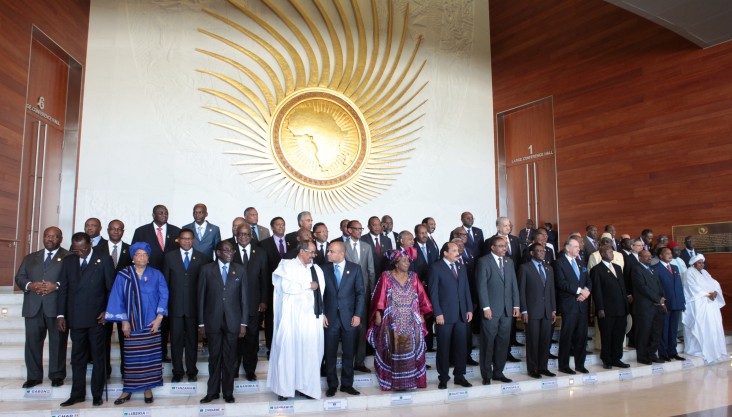- Where We Work
- Africa
- African Union
- Power Africa
- Trade and Investment
- Angola
- Benin
- Botswana
- Burkina Faso
- Burundi
- Cameroon
- Central Africa Regional
- Central African Republic
- Chad
- Côte d'Ivoire
- Democratic Republic of the Congo
- Djibouti
- East Africa Regional
- Eswatini
- Ethiopia
- Ghana
- Guinea
- Kenya
- Lesotho
- Liberia
- Madagascar
- Malawi
- Mali
- Mauritania
- Mozambique
- Namibia
- Niger
- Nigeria
- Republic of the Congo
- Rwanda
- Sahel Regional
- Senegal
- Sierra Leone
- Somalia
- South Africa
- South Sudan
- Southern Africa Regional
- Sudan
- Tanzania
- The Gambia
- Uganda
- West Africa Regional
- Zambia
- Zimbabwe
- Asia
- Europe and Eurasia
- Latin America and the Caribbean
- Middle East
- Mission Directory
Speeches Shim

The Organization of African Unity and the African Union
On May 25 1963 in Addis Ababa, Ethiopia, the 32 African states that had achieved independence at that time agreed to establish the Organization of African Unity (OAU). A further 21 members joined gradually, reaching a total of 53 by the time of the AU’s creation in 2002. On 9 July 2011, South Sudan became the 54th African Union (AU) member.
The OAU’s main objectives, as set out in the OAU Charter, were to promote the unity and solidarity of African states; coordinate and intensify their cooperation and efforts to achieve a better life for the peoples of Africa; safeguard the sovereignty and territorial integrity of Member States; rid the continent of colonisation and apartheid; promote international cooperation within the United Nations framework; and harmonise members’ political, diplomatic, economic, educational, cultural, health, welfare, scientific, technical and defence policies.
The OAU operated on the basis of its Charter and the 1991 Treaty Establishing the African Economic Community (known as the Abuja Treaty). Its major organs were the Assembly of Heads of State and Government, Council of Ministers and the General Secretariat as well as the Commission of Mediation, Conciliation and Arbitration; Economic and Social Commission; Educational, Scientific, Cultural and Health Commission; and Defence Commission. The Commission of Mediation, Conciliation and Arbitration was replaced by the Mechanism for Conflict Prevention, Management and Resolution in 1993.
Transition to the African Union
Through the 1990s, leaders debated the need to amend the OAU’s structures to reflect the challenges of a changing world. In 1999, the OAU Heads of State and Government issued the Sirte Declaration calling for the establishment of a new African Union. The vision for the Union was to build on the OAU’s work by establishing a body that could accelerate the process of integration in Africa, support the empowerment of African states in the global economy and address the multifaceted social, economic and political problems facing the continent. In total, four summits were held in the lead up to the official launching of the African Union, the:
- Sirte Summit (1999), which adopted the Sirte Declaration calling for the establishment of the AU
- Lomé Summit (2000), which adopted the AU Constitutive Act
- Lusaka Summit (2001), which drew the road map for implementation of the AU
- Durban Summit (2002), which launched the AU and convened its first Assembly of Heads of State and Government.
A significant number of OAU structures were carried forward into the AU. Similarly, many of the OAU’s core commitments, decisions and strategy frameworks continue to frame AU policies. However, while the footprint of the OAU is still strong, the AU Constitutive Act and protocols established a significant number of new structures, both at the level of major organs and through a range of new technical and subsidiary committees. Many of these have evolved since 2002 and some are still under development.
United States Mission to the African Union
The goal of the United States Mission to the African Union (USAU) is to partner with the African Union in ways that will strengthen democratic institutions, promote peace and stability, support sustainable economic development through increased trade and investment, and improve the lives and health of all Africans. USAU's relationship with the AU is based upon historical ties and shared culture between Africa and the U.S., increasing coordination due to globalization, and a deep appreciation of the strategic significance of the African continent.
To this end, USAU is pursuing a program focused on the following objectives that both we and the AU recognize as vital to the future:
- Good Governance and Democracy
- Peace and Security
- Shared Values and Communications
USAID Support to the African Union
The African Union’s vision is to support “an integrated, prosperous, and peaceful Africa, driven by its own people and representing a dynamic force in the global arena.” In August 2010, USAID and the African Union signed their first long-term assistance agreement to advance prosperity, peace, and stability in Africa.

Comment
Make a general inquiry or suggest an improvement.